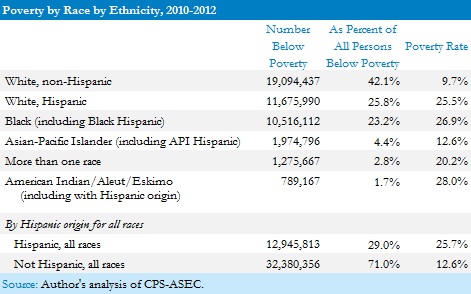November 13, 2013
In an excellent online commentary for the New York Times, Mark Rank, a professor of social welfare at Washington University in St. Louis corrects much of the current conventional wisdom about poverty in the United States.
For example, he explains that poverty is more dispersed than is commonly recognized with respect to both time (“nearly 40 percent of Americans between the ages of 25 and 60 will experience at least one year below the official poverty line …, and 54 percent will spend a year in poverty or near poverty…”) and place (only about 10 percent of people with below-poverty annual incomes live in extremely poor urban neighborhoods). And he concludes by rightly noting that effective anti-poverty policies will “become a reality only when we begin to truly understand that poverty is an issue of us, rather than them.”
That said, I do have two picky points to add.
First, while Rank correctly says that about two-thirds of people with below-poverty incomes identify as white, it’s also worth noting that many of these self-identified whites living in poverty also identify as Latino. As the table below shows, about 58 percent of people living below the line are Latino, black, Asian/Pacific Islander, or Native American. Of course, this doesn’t mean that poverty today is any less an “issue of us, rather than them.” Census projects that non-Hispanic whites will become a minority within three decades and half of all youth will people of color by the end of this decade. In short, the demographics of poverty are best viewed as a leading indicator of the real and constantly evolving American “us.”

Second, while poverty is, as Rank puts it, mainstream in the United States, it’s also something that happens to the working class more than the middle class, and the upper class barely at all. Class isn’t really mentioned in Rank’s piece—or in most media discussions of poverty, except for occasional mentions of that old Charles-Murray-by way-of-Freidrich-Nieztsche chestnut: The Underclass—so it’s worth remembering that low-income people most often self-identify in class terms as working class (and not as “poor” or “lower class”).






